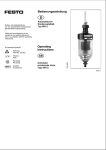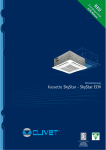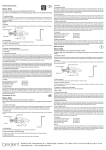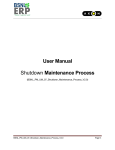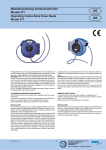Download EwoFN330-132 DE-GB
Transcript
Einbau- und Bedienungsanleitung für Vollautomatisches Ablassventil Modell 441 Fitting and Operating Instructions for Fully Automatic Drain Valve Model 441 Vollautomatisches Einbauablassventil Fully Automatic Attachable Drain Valve DE GB Vollautomatisches Anbauablassventil External-Automatic Drain Valve für Filter, Filterdruckregler und Kombiwartungseinheiten. For filters, filter pressure relievers and combination units. Bei nachträglicher Umrüstung nur komplett mit Behälter verwenden. For installation in compressed air containers, compressed air piping etc. Automatisches schwimmerbetätiges Ablassventil. Arbeitsreich 1,5 bis 12 bar. Unter ca. 1 bar ist das Ventil offen. Höhere Drücke als 12 bar sind unbedingt zu vermeiden, da dann das Ventil nicht mehr öffnet. Grobe Schmutzteile werden durch ein Sieb zurückgehalten. Das Servoventil ist gegen Flüssigkeiten von oben geschützt. Automatic, float-operated drain valve. Operating range 1,5 to 12 bars. The valve is open at less than about 1 bars. Pressures in excess of 12 bars must be avoided if at all possible, since the valve will then no longer open. Coarse dirt particles are held back by the strainer. The servo-valve is protected against liquids from above. Einbau Installation Einbauablassventil – Der Einbau ist nur in Behälter mit Verdrehsicherung SW 19 am Boden möglich, da das Ventil nicht durch Festhlten am Schwimmer oder Schirm verdreht werden darf. Bei Montage darf die Mutter nicht extrem angezogen werden, um Spannungen im Kunststoffbehälter zu vermeiden. Anbauablassventil – Das Ventil kann in Filter, Filterdruckregler und Kombiwartungseinheiten ansltelle der Handablassschraube mit Gewinde G 1/8 eingeschraubt werden. Fully Automatic Drain Valve – Installation is only possible in bowls with wrench size 19 on the bottom, because the valve must not screwed up by holding the float or the shield. After installation, the nut must not tighten too closely to sroid tensions in the plastic bowl. Technische Daten Max. Betriebsdruck: Schliessdruck: Schliessdurchfluss: Betriebstemperatur: Einbaulage: Handbetätigung: Kondensatableitung: Specifikations Max. working pressure: Closing pressure: Closing flow: Operating temperature:: Installation position: Manual operating feature: Condensate draining: *) Siehe Abschnitt: Wirkungsweise 12 bar ~ 1,5 bar 7,5 m³/h *) 0°C bis +50°C senkrecht ± 5° Rote Scheibe nach oben drücken *) Tülle für Schlauch LW 5 *) External-Automatic Drain valve – The fully automatic drain valve can be screwed into all filters, filter pressure relievers and combination units instead of the manually operated drain valve. Connecting thread G 1/8. *) See section: Mode of operation 12 bars approx. 1,5 bar 7,5 m³/h *) 0°C to +50°C vertical ± 5° press red ring *) socket for size 5 hose *) Wirkungsweise Bis zu einem Behälterinnedruck von ca. 1,5 bar ist das Ventil geöffnet (siehe linke Seite des Schnittbildes). Damit sich der Schliessdruck von 1,5 bar aufbauen kann, ist eine Durchflussmenge von ca. 7,5 m³/h erforderlich. Dies ist zu beachten, wenn z.B. bei enem Kleinkompressor von „Null“ angefahren werden soll. Zwischen1,5 und 12 bar öffnet das Ventil bei Erreichen eines bestimmten Kondensatstandes automatisch. Das Kondensat hebt den Schwimmer an, dieser über einen Hebel den Dichtkegel von der Servodüse. Die einströmende Luft drückt den Servokolben nach unten und öffnet das Ablassventil. Wird die Düse durch den absinkenden Schwimmer wieder geschlossen, schliesst auch das Ablassventil. Zur Handbetätigung des Ventils kann die Tülle am roten Ring nach oben gedrückt werden, dadurch wir das Ventil geöffnet. Bei höheren Innendrücken ist die Betätigung entsprechend schwergängig. Wird zur Ableitung des Kondensats ein Schlauch (LW 5) verwendet, sollte dieser flexibel sein, damit keine Kräfte auf das Ventil ausgeübt werden. Mode of operation The valve is open up to an internal container pressure of about 1,5 bars (see left side of diagram). To permit build-up of the 1,5 bar clossing pressure, a flow rate of about 7,5 m³/h is necessary. This should be noted when starting is to be from „zero“, for example in the case of a small compressor. Between 1,5 and 12 bars, the valve opens automatically when a certain condensate level is reached. The condensate lifts the float, which in turn lifts the sealing cone off the servo-nozzle by means of a lever. The air now flowing in presses the servo-piston downwards and opens the drain valve. When the nozzles closes again as the float falls, the drain valve too closes. To operate the valve manually, the socket on the red ring can be pressed upwards, thereby opening the valve. At higher internal pressures, this operating requires a correspondingly greater effort. If a hose (clear width 6) is used to drain off the condensate, itshould be flexible, so that no forces are exterted on the valve. Wartung Das Ventil arbeitet bei normalen Bedingungen wartungsfrei. Sehr hoher Schmutzanteil erfordert eine gelegentliche Reinigung des Siebes in ausgebautem Zustand. Maintenance The valve is maintenance-free in normal operating conditions. Very heavy dirt requires occasional cleaning of the strainer after removal of the latter. Störungen und Ursache Behebung von Störungen Trouble and its Causes richtigstellen richtigstellen freiblasen *) oder Bohrung reinigen freiblasen *) Valve does not close Container pressure is below 1,5 bars Flow rate is too low (7,5 m³/h) Relief hole in positon is clogged (0,1 mm) Servo-section is flooded Ventil öffnet nicht Behälter über 12 bar Behälter hängt schief, >5° richtigstellen richtigstellen Valve does not open Container pressure is above 12 bars Container is slanted more than 5° Correct it Correct it Ventil ist undicht Dichtung Ablassventil verschmutzt Dichtung Servoventil beschädigt freiblasen *) Reparatur im Werk Valve leaks Seal of drain valve is clogged Seal of servo-valve is damaged Blow it clear *) Have it repaired by the factory Ventil schliesst nicht Behälter unter 1,5 bar Durchfluss zu klein, 7,5 m³/h Entlastungsbohrung im Kolben Verstopft (0,1 mm) Servoteil überflutet Remedial action Correct it Correct it Blow it clear *) or clean the hole Blow it clear *) *) mit Freiblasen ist das mehrmalige und länger andauernde Betätigen der Handbetätigung gemeint. *) Blowing clear is achieved using the manual operation feature several times and for fairly long periods. Zum Auswechseln von Dichtungen sind Spezialwerkzeuge erforderlich. Solche und ähnliche Reparaturen sollten daher nur im Werk vorgenommen werden. Special tools are needed to change the seals. These and similar operations should therefore only be performed in factory. FN330-132A RRSS 5 02/08


